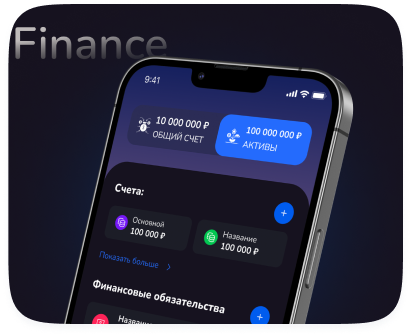
We build mobile apps





We work directly with every client
We deliver solutions with guaranteed results.

We build mobile apps






















It’s similar to buying a car at a dealership: you can go with the basic model, or choose a fully loaded version — it all depends on your needs and goals.

How to create YOUR OWN ChatGPT?

How to PROPERLY create a mobile app in 2024 | Step by step

You pay > We work > You receive the results. If you’re satisfied, you pay the next installment.
We need to have a call and discuss your specific requirements.
One thing we can say for sure: projects under 500,000 rubles are not feasible — we can’t deliver the required quality for less.
We launch, gather user feedback, and add new features that help you earn more from the app.
During development, I always design the architecture to make future updates and improvements easy and convenient.
Some apps perform better with influencer marketing, others through ad networks, and sometimes it’s even effective to buy a contact list and set up retargeting 😊
It all depends on your project’s specifics and is discussed personally.
How we can help:
- Set up ASO (App Store Optimization) and create an attractive app store page to drive free, organic installs.
- Help you develop the right promotion strategy tailored to your app.
- Share contacts of advertising experts I personally work with.
Спросить ChatGPT
The only ongoing cost is paying for the server (hosting).
You pay a subscription fee for the server. The more users your app has, the more server resources it consumes, and the higher the hosting costs.
At the early stages, when you have few users, the server will be FREE.
After that, the cost will gradually increase, but it remains affordable.
For example, an app with 100,000 users spent about $150 per month on hosting.
App Development Cost in 2025: Get a Transparent Estimate
Get a Transparent Estimate for App Development Cost in 2025. Explore the factors influencing pricing and budgeting for your mobile app project.
Introduction
In the ever-evolving landscape of technology, mobile applications continue to dominate how we interact with the world. From streamlining business operations to providing entertainment and connecting people, apps have become indispensable. However, bringing a mobile app to life involves significant investment, and understanding the potential costs is crucial for project success. This article provides a comprehensive overview of the factors influencing app development cost in 2025, helping you create a realistic budget and achieve your app development goals.
Understanding the Factors Influencing App Development Cost
Several factors contribute to the overall mobile app development cost. These can be broadly categorized into complexity, platform choice, design requirements, development team, and ongoing maintenance.
1. App Complexity
The complexity of your app is arguably the most significant cost driver. Complexity is determined by the features, functionalities, and integrations required for the app. Simple apps with basic functionality will naturally cost less than feature-rich applications with complex backend systems, data processing, and external API integrations.
Types of App Complexity:
- Basic Apps: These typically involve simple content display, user login, and limited data interaction. Examples include basic calculators, tip calculators, and simple informational apps.
- Medium Complexity Apps: These apps often feature user accounts, data storage, and some level of integration with external services. Examples include social media apps with limited features, e-commerce apps with basic product listings, and task management apps.
- Complex Apps: These are feature-rich applications that often incorporate advanced technologies such as AI, machine learning, real-time data processing, and intricate user interfaces. Examples include complex e-commerce platforms, social networking apps with advanced features, and enterprise-level applications.
2. Platform Choice (iOS, Android, or Cross-Platform)
The platform you choose to develop your app for also influences the cost. You can choose to develop natively for iOS, Android, or opt for a cross-platform solution.
Native vs. Cross-Platform Development:
- Native Development (iOS or Android): Native apps are built specifically for a particular operating system (iOS or Android). They offer the best performance and access to device-specific features. However, developing native apps for both platforms requires separate codebases and, therefore, higher costs.
- Cross-Platform Development: Cross-platform frameworks allow you to write code once and deploy it on multiple platforms (iOS and Android). This can significantly reduce development time and cost, but may come with some performance trade-offs compared to native apps. Popular cross-platform frameworks include React Native, Flutter, and Xamarin.
3. Design Requirements (UI/UX)
A well-designed user interface (UI) and user experience (UX) are crucial for app success. Investing in a visually appealing and intuitive design can significantly improve user engagement and retention. However, custom designs and animations can increase development costs.
UI/UX Design Considerations:
- User Interface (UI): This refers to the visual elements of the app, including the layout, color scheme, typography, and icons.
- User Experience (UX): This encompasses the overall experience of using the app, including its usability, accessibility, and efficiency.
- Custom Designs vs. Template-Based Designs: Custom designs offer greater flexibility and allow you to create a unique brand identity. However, they are more expensive than using pre-built templates.
4. Development Team (Freelancers, Agency, In-House)
The composition and location of your development team will also impact the app development cost. You can choose to hire freelancers, outsource to an agency, or build an in-house team.
Team Options:
- Freelancers: Hiring freelancers can be a cost-effective option for smaller projects. However, it requires careful management and coordination.
- Development Agency: Agencies offer a full range of services, including design, development, and testing. They typically have more experience and expertise, but are also more expensive than freelancers.
- In-House Team: Building an in-house team provides greater control over the development process, but it requires significant investment in recruitment, training, and infrastructure.
5. Ongoing Maintenance and Support
App development cost doesn't end with the initial launch. Ongoing maintenance and support are essential for ensuring the app's stability, security, and performance. This includes bug fixes, updates, and server maintenance.
Maintenance and Support Costs:
- Bug Fixes: Addressing any issues or errors that arise after the app is launched.
- Updates: Implementing new features, improving performance, and ensuring compatibility with the latest operating systems.
- Server Maintenance: Maintaining the servers that host the app's backend and data.
6. Backend Infrastructure
The backend infrastructure is the backbone of many mobile applications, responsible for data storage, user authentication, and API management. The complexity and scalability of this infrastructure significantly affect the overall development cost.
Backend Considerations:
- Data Storage: The choice of database (e.g., MySQL, PostgreSQL, MongoDB) and storage solution impacts cost. Cloud-based solutions like AWS, Azure, or Google Cloud offer scalability but incur ongoing costs.
- API Development and Management: Creating and managing APIs for communication between the app and the backend requires expertise and resources. API gateways and security measures add to the complexity and cost.
- Server Infrastructure: The type of servers (e.g., dedicated, virtual, cloud) and their management contribute to the overall cost. Cloud solutions offer scalability but require continuous monitoring and optimization.
7. Testing and Quality Assurance
Thorough testing and quality assurance are essential to ensure the app functions correctly and provides a seamless user experience. This involves various testing methodologies, including unit testing, integration testing, and user acceptance testing.
Testing Methodologies:
- Unit Testing: Testing individual components of the app to ensure they function as expected.
- Integration Testing: Testing the interaction between different components of the app.
- User Acceptance Testing (UAT): Allowing end-users to test the app and provide feedback before launch.
- Automated Testing: Using tools to automate repetitive testing tasks, which can save time and money in the long run.
Estimating App Development Cost in 2025
While it's impossible to provide an exact figure without a detailed project specification, we can provide a general estimate based on the complexity of the app.
- Basic App: $10,000 - $30,000
- Medium Complexity App: $30,000 - $70,000
- Complex App: $70,000+
These are just estimates, and the actual cost can vary depending on the specific requirements of your project. Factors such as the location of the development team, the complexity of the design, and the level of ongoing maintenance can all impact the final cost.
Factors Increasing Cost in 2025
Several trends and technological advancements are expected to influence app development cost in 2025:
- AI and Machine Learning Integration: Implementing AI-powered features, such as chatbots, personalized recommendations, and image recognition, will require specialized expertise and increase development costs.
- Augmented Reality (AR) and Virtual Reality (VR) Features: Integrating AR/VR functionalities will demand advanced hardware and software development, adding to the overall cost.
- Increased Security Requirements: As cyber threats become more sophisticated, implementing robust security measures to protect user data and privacy will be essential, leading to higher development and maintenance costs.
- Blockchain Integration: Integrating blockchain technology for secure transactions and data management will require specialized expertise and add to the development complexity and cost.
Strategies to Reduce App Development Cost
While developing a mobile app can be a significant investment, there are several strategies you can employ to reduce costs without compromising quality:
- Prioritize Features: Focus on the core features that are essential for your app's success and postpone less critical features for future updates.
- Use Pre-Built Components and Libraries: Leverage existing libraries and components to reduce development time and cost.
- Choose a Cost-Effective Development Team: Consider hiring freelancers or outsourcing to agencies in countries with lower labor costs.
- Use Agile Development Methodologies: Agile development allows for flexibility and iterative development, which can help identify and address potential issues early on, reducing rework and costs.
- Thorough Planning and Documentation: Investing time in detailed planning and documentation can prevent misunderstandings and ensure that the development team has a clear understanding of the project requirements, reducing the risk of costly errors.
Table: Estimated App Development Cost Breakdown
| Feature | Basic App | Medium Complexity App | Complex App |
|---|---|---|---|
| UI/UX Design | $2,000 - $5,000 | $5,000 - $15,000 | $15,000+ |
| Front-End Development | $3,000 - $7,000 | $7,000 - $20,000 | $20,000+ |
| Back-End Development | $2,000 - $6,000 | $6,000 - $18,000 | $18,000+ |
| Testing and QA | $1,000 - $3,000 | $3,000 - $8,000 | $8,000+ |
| Project Management | $1,000 - $4,000 | $4,000 - $9,000 | $9,000+ |
| Server and Infrastructure (1 year) | $500 - $1500 | $1500 - $5000 | $5000+ |
Note: These are estimated costs and can vary widely based on specific project requirements.
Conclusion
Estimating app development cost in 2025 requires careful consideration of various factors, including app complexity, platform choice, design requirements, and the development team. By understanding these factors and employing cost-saving strategies, you can create a realistic budget and successfully launch your mobile app. Remember to prioritize features, choose a cost-effective development team, and invest in thorough planning and documentation. Ultimately, the key to successful app development lies in balancing cost with quality to create an app that meets your business objectives and provides a valuable user experience.






